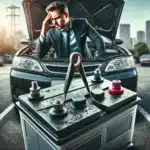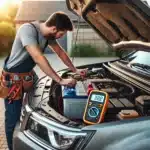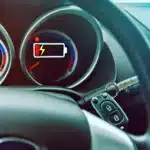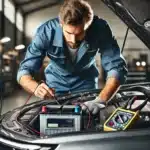A car battery might seem like just another part of your vehicle, but it’s actually a vital component that powers everything from your headlights to your radio. In this comprehensive guide, we’ll explore what a car battery is, how it functions, and why it’s so important for your car’s operation.
Table of contents
What Is a Car Battery
A car battery is a rechargeable power source. It provides the electrical energy needed to start the engine and powers various electrical components when the engine isn’t running. Most car batteries are lead-acid batteries, which consist of lead plates submerged in an electrolyte solution of sulfuric acid and water.
What are the Components of a Car Battery
1. Lead Plates
These are the main components that store electrical energy. The battery contains multiple lead plates submerged in an electrolyte solution.
2. Electrolyte
Typically made of sulfuric acid and water, the electrolyte facilitates the chemical reactions needed to generate electricity.
3. Separator
This prevents the lead plates from touching each other and causing a short circuit.
4. Terminals
These are the points where the battery connects to the vehicle’s electrical system.
What is a car battery made of
The car battery is essential for starting your vehicle and powering its electrical systems. But what exactly starts a car battery when it’s not functioning?
1. Power Flow from the Battery
The process begins with a critical power flow from your battery. Your car’s 12-volt battery sends an electrical current through heavy-duty cables designed to handle the massive amount of power needed to start the engine. This initial surge of electricity powers up your entire starting system, setting everything in motion.
2. Mechanical Action Phase
Next comes the mechanical action phase. The starter gear extends outward, making contact with the engine’s flywheel. This connection creates the physical link needed to transform electrical energy into the mechanical force that will turn your engine. The starter motor engages with the flywheel, enabling the conversion of electrical power into rotational motion.
3. Engine Start Phase
Finally, we reach the engine start phase. As the starter spins the flywheel, your engine’s pistons begin their movement. This motion draws the fuel-air mixture into the cylinders. Once the mixture is in place, it ignites, and your engine roars to life. At this point, the engine takes over, and the starter’s job is complete, having successfully initiated the combustion process.
What is the 5 function of a battery
A battery serves several critical functions in a vehicle and other applications. Here are five primary functions of a battery:
1. Powering the Starter Motor
The battery provides the necessary electrical energy to power the starter motor. When you turn the ignition key, the battery sends a surge of current that engages the starter, enabling it to crank the engine and initiate the combustion process.
2. Supplying Electrical Power
The battery supplies electrical power to the vehicle’s electrical systems when the engine is off. This includes powering lights, radio, air conditioning, and other accessories. It ensures that these components operate without needing the engine running.
3. Storing Energy
A battery stores electrical energy in the form of chemical energy. It absorbs the energy generated by the alternator when the engine is running, allowing it to recharge and maintain a reserve of power for future use.
4. Stabilizing Voltage
The battery helps stabilize voltage levels within the electrical system. It acts as a buffer, smoothing out fluctuations in voltage caused by the alternator and other electrical loads. This stabilization protects sensitive electronic components from damage due to voltage spikes.
What is the purpose of a battery in a car
Here are the main purposes of a car battery:
1. Starting the Engine
The primary purpose of a car battery is to provide the electrical energy needed to start the engine. When you turn the ignition key or press the start button, the battery sends a surge of electricity to the starter motor, allowing it to crank the engine and initiate the combustion process.
2. Powering Electrical Systems
The battery supplies power to the car’s electrical systems when the engine is off. This includes essential components such as lights, radio, air conditioning, and dashboard instruments. It ensures that these systems function without the engine running.
3. Storing Electrical Energy
A car battery stores electrical energy generated by the alternator while the engine is running. This stored energy is crucial for providing power during engine start-up and for operating electrical accessories when the engine is not running.
4. Voltage Regulation
The battery helps regulate voltage levels within the vehicle’s electrical system. It acts as a buffer to smooth out voltage fluctuations, protecting sensitive electronic components and systems from potential damage caused by spikes or drops in voltage.
5. Providing Backup Power
In case of alternator failure or when the engine is off, the battery serves as a backup power source. It ensures that critical electrical systems continue to function, allowing you to start the car and operate essential accessories even when the engine is not running.
6. Facilitating Regenerative Braking (in Electric Vehicles)
In electric and hybrid vehicles, the battery plays a crucial role in regenerative braking. During braking, the electric motor can reverse and act as a generator, converting kinetic energy back into electrical energy, which is stored in the battery for later use. This function enhances the vehicle’s energy efficiency.
How Does a Battery Work – Step by Step
Your car battery might look simple from the outside, but inside, it’s a powerhouse of chemical reactions. Picture six small containers housed within that black box. Each container, which we call cells, works together to create the power your car needs.
1. Basic Structure of a Battery
A typical battery consists of three main components:
Anode (Negative Terminal): The electrode where oxidation occurs. In a lead-acid battery, this is made of sponge lead.
Cathode (Positive Terminal): The electrode where reduction occurs. In a lead-acid battery, this is made of lead dioxide (PbO2).
Electrolyte: A chemical medium (often a liquid) that allows ions to move between the anode and cathode, facilitating the chemical reactions.
2. Chemical Reactions
When the battery is connected to a circuit (like when starting a car), the following chemical reactions take place:
At the Anode: The lead (Pb) oxidizes, releasing electrons and forming lead sulfate (PbSO4).
At the Cathode: The lead dioxide (PbO2) reacts with the sulfate ions (SO4^{2-}) and electrons (e^-) from the anode to form lead sulfate (PbSO4) and water (H2O).
| Site | Reaction | Products | Reactants |
|---|
| Anode | Pb → Pb²⁺ + 2e⁻ | Lead sulfate (PbSO₄), Electrons (e⁻) | Lead (Pb) |
| Cathode | PbO₂ + 3H₂SO₄ + 2e⁻ → PbSO₄ + 2H₂O | Lead sulfate (PbSO₄), Water (H₂O) | Lead dioxide (PbO₂), Sulfate ions (SO₄²⁻), Electrons (e⁻) |
3. Electron Flow
As the anode oxidizes, it releases electrons. These electrons flow through the external circuit (for example, powering the starter motor in a car) towards the cathode.
This flow of electrons generates electric current, which can be used to power electrical devices.
4. Ionic Movement
While electrons flow through the external circuit, ions move through the electrolyte inside the battery.
Positively charged ions (cations) move toward the cathode, and negatively charged ions (anions) move toward the anode. This movement maintains charge balance and enables the continued flow of current.
5. Discharge and Recharge
During discharge (when the battery is powering a device), the chemical reactions described above occur until the reactants are depleted.
In rechargeable batteries, once the battery is connected to a charger, the process is reversed:
Electrical energy from the charger forces the chemical reactions to go in the opposite direction, restoring the original compounds (lead and lead dioxide) and recharging the battery.
6. Understanding Voltage and Current
The voltage of a battery is determined by the materials used in its electrodes. Higher voltage means more potential energy available for work. The relationship between power (P), voltage (V), and current (I) is given by:
P=V×I
Conclusion
The car battery is important for starting the engine and powering electrical systems. It converts stored chemical energy into electrical energy when you turn the ignition key. Proper maintenance is crucial for extending its lifespan and ensuring reliable performance. A well-maintained battery is vital for your vehicle’s functionality.
Uncover more details now: How to Read Car Battery Specifications Like a Pro







